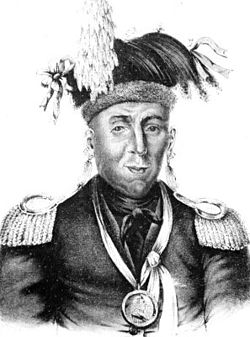- Waubonsie
-
- Many spelling variations of "Waubonsie" redirect here. For other uses, see Wabaunsee (disambiguation).
Waubonsie (c. 1760 – c. 1848) was a leader of the Potawatomi Native American people. His name has been spelled in a variety of ways, including Wabaunsee, Wah-bahn-se, Waubonsee, Waabaansii in the contemporary Ojibwe language, and Wabansi in the contemporary Potawatomi language.
Contents
Biography
The documentary record of Waubonsie's life is sparse. His birth name, parentage, and place of birth are unknown.[1] The year of his birth has been estimated from 1756 to 1765.[1] His brother Mucadapuckee ("Black Partridge") was also a chief.[1] According to tradition, Waubonsie acquired his name (which means "Break of Day"[1] or "He Causes Paleness"[2]) after sneaking into a place where some enemy Osages were located, killing and scalping one or more of them, and escaping at daybreak.[1]
During Tecumseh's War and the War of 1812, Waubonsie supported Tecumseh and the British against American expansion. In September 1811, Waubonsie led an attack on one of William Henry Harrison's supply boats as it ascended the Wabash River in Indiana. Waubonsie jumped on the boat, killed the lone American on board, and lept off before the Americans on the far shore could respond.[2] Waubonsie, Shabonna, and Winamac led Potawatomi warriors against Harrison's troops at the Battle of Tippecanoe on November 7, 1811.[3]
Waubonsie opposed the attack on Fort Dearborn in 1812, and protected the family of John Kinzie during the massacre that followed.[1] After the war, he signed treaties with the United States, and thereafter worked to avoid confrontation with the Americans. With other Potawatomi leaders, in 1827 he refused to join the Winnebago War against the Americans.[4]
When the Black Hawk War erupted in 1832, Waubonsie and other Potawatomi leaders worked to keep their people out of the conflict, but found it difficult to do so.[5] Many white settlers, recalling the Fort Dearborn massacre, distrusted the Potawatomis and assumed that they would join Sauk leader Black Hawk's uprising.[6] Potawatomi leaders worried that the tribe as a whole would be punished if any Potawatomis supported Black Hawk. Waubonsie and Potawatomi chief Shabbona and told Black Hawk that they would not come to his aid.[7] Hoping to demonstrate their good intentions to the Americans, the Potawatomis offered military assistance, fielding a force under Billy Caldwell and Waubonsie. They were less than enthusiastic allies, but managed to demonstrate support for the Americans while avoiding battle.[8]
After the war, Waubonsie visited Washington D.C. on two occasions, and met once with President Andrew Jackson.[1] He signed treaties that sold Potawatomi land in Indiana and Illinois to the United States, and moved westward to Iowa. The U.S. government built Waubonsie a house near Tabor, Iowa, where he died in 1848 or 1849.[1]
Toponyms
- Waubonsie State Park, Iowa
- Wabaunsee County, Kansas
- Wabaunsee Township, Kansas
- Wabaunsee Creek, Kansas
- Lake Wabaunsee, Kansas
- Waubonsie Valley High School, Aurora, Illinois
- Waubonsee Community College, Sugar Grove, Illinois
USS Waubansee (YTM-366), a United States Navy harbor tug placed in service in 1944 and stricken in 1983, was also named for him.
References
- ^ a b c d e f g h David Holmgren (2009). "Waubonsie". The Biographical Dictionary of Iowa. University of Iowa Press Digital Editions. http://digital.lib.uiowa.edu/uipress/bdi/DetailsPage.aspx?id=396. Retrieved March 27, 2011.
- ^ a b R. David Edmunds, The Potawatomis: Keepers of the Fire (University of Oklahoma Press, 1978, ISBN 0806114789), 176.
- ^ Edmunds, 176–77.
- ^ Edmunds, 231.
- ^ John W. Hall, Uncommon Defense: Indian Allies in the Black Hawk War (Harvard University Press, 2009, ISBN 0674035186), 125.
- ^ Hall, 122.
- ^ Patrick J. Jung, The Black Hawk War of 1832, (University of Oklahoma Press, 2008, ISBN 0806139943), 86–87.
- ^ Hall, 165–67.
External links
- Kansas State Historical Society Quarterly
- Treaty with the Potawatomi text
- "Chief Waubonsie". Potawatomi Indian Chief. Find a Grave. Oct 23, 2003. http://www.findagrave.com/cgi-bin/fg.cgi?page=gr&GRid=8029957. Retrieved Aug 18, 2011.
Categories:- 1840s deaths
- Aboriginal people of the War of 1812
- Algonquian personal names
- Native American leaders
- People of the Black Hawk War
- Potawatomi people
Wikimedia Foundation. 2010.

